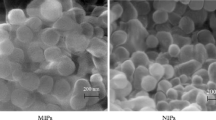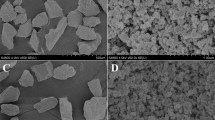Abstract
This article demonstrates the feasibility of an alternative strategy for producing temperature sensitive molecularly imprinted microspheres (MIMs) for solid-phase dispersion extraction of malachite green, crystal violet and their leuko metabolites. Thermo-sensitive MIMs can change their structure following temperature stimulation. This allows capture and release of target molecules to be controlled by temperature. The fabrication technique provides surface molecular imprinting in acetonitrile using vinyl modified silica microspheres as solid supports, methacrylic acid and N-isopropyl acrylamide as the functional monomers, ethyleneglycol dimethacrylate as the cross-linker, and malachite green as the template. After elution of the template, the MIMs can be used for fairly group-selective solid phase dispersion extraction of malachite green, crystal violet, leucomalachite green, and leucocrystal violet from homogenized fish samples at a certain temperature. Following centrifugal separation of the microspheres, the analytes were eluted with a 95:5 mixture of acetonitrile and formic acid, and then quantified by ultra-high performance liquid chromatography tandem mass spectrometry (UHPLC-MS/MS) with isotope internal calibration. The detection limits for malachite green, crystal violet and their metabolites typically are 30 ng·kg−1. Positive samples were identified by UHPLC-MS/MS in the positive ionization mode with multiple reaction monitoring. The method was applied to the determination of the dyes and the respective leuko dyes in fish samples, and accuracy and precision were validated by comparative analysis of the samples by using aluminum neutral columns.

We describe an alternative strategy for producing temperature sensitive molecularly imprinted microspheres for solid-phase dispersion extraction of malachite green, crystal violet and their metabolites in fish samples.





Similar content being viewed by others
References
Cho BP, Yang T, Blankenship LR, Moody JD, Churchwell M, Bland FA, Clup SJ (2003) Synthesis and characterization of N-demethylated metabolites of malachite green and leucomalachite green. Chem Res Toxicol 16:285–294
Fessard V, Godard T, Heut A, Mourot A, Poul JM (1999) Mutagenicity of malachite green and leucomalachite green in in-vitro tests. J Appl Toxicol 19:421–430
Plakas SM, Doerge DR, Turnipseed SB (1999) Xenobiotics in fish. In: Barker B (ed) Disposition and metabolism of malachite green and other therapeutic dyes in fish. Kluwer Academic/Plenum Publisher, New York, pp. 149–166
Love DC, Rodman S, Neff RA, Nachman KE (2011) Veterinary drug residues in seafood inspected by the European Union, United States, Canada, and Japan from 2000 to 2009. Environ Sci Technol 45:7232–7240
Tarbin JA, Barnes KA, Bygrave J, Farrington WH (1998) Screening confirmation of triphenylmethane dyes and their leuco metabolites in trout muscle HPLC-Vis and ESP-LC-MS. Analyst 123:2567–2571
Dowling G, Mulder PPJ, Duffy C, Regan L, Smyth MR (2007) Confirmatory analysis of malachite green, leucomalachite green, crystal violet and leucocrystal violet in salmon by liquid chromatography-tandem mass spectrometry. Anal Chim Acta 586:411–419
Xie J, Peng T, Chen DD, Zhang QJ, Wang GM, Wang X, Guo Q, Jiang F, Chen D, Deng J (2013) Determination of malachite green, crystal violet and their leuco-metabolites in fish by HPLC–VIS detection after immunoaffinity column clean-up. J Chromatogr B 913-914:123–128
Andersen WC, Turnipseed SB, Karbiwnyk CM, Lee RH, Clark SB, Rowe WD, Madson MR, Miller KE (2009) Multiresidue method for the triphenylmethane dyes in fish: malachite green, crystal (gentian) violet, and brilliant green. Anal Chim Acta 637:279–289
Wu X, Zhang G, Wu Y, Hou X, Yuan Z (2007) Simultaneous determination of malachite green, gentian violet and their leuco-metabolites in aquatic products by high-performance liquid chromatography–linear ion trap mass spectrometry. J Chromatogr A 1172:121–126
Arroyo D, Ortiz MC, Sarabia LA, Palacios F (2009) Determination and identification, according to European Union decision 2002/657/EC, of malachite green and its metabolite in fish by liquid chromatography–tandem mass spectrometry using an optimized extraction procedure and three-way calibration. J Chromatogr A 1216:5472–5482
Yang MC, Fang JM, Kuo TF, Wang DM, Huang YL, Liu LY, Chen PH, Chang TH (2007) Production of antibodies for selective detection of malachite green and the related triphenylmethane dyes in fish and fishpond water. J Agric Food Chem 55:8851–8856
Stoklker AAM, Brinkman UAT (2005) Analytical strategies for residue analysis of veterinary drugs and growth-promoting agents in food-producing animals—a review. J Chromatogr A 1067:15–23
Plotka-Wasylka J, Szczepańska N, Guardia MD, Namieśnik J (2015) Modern trends in solid phase extraction: new sorbent media. Trac-trend. Anal Chem 77:23–43
Chen G, Miao S (2010) HPLC determination and MS confirmation of malachite green, gentian violet, and their leuco metabolite residues in channel catfish muscle. J Agric Food Chem 58:7109–7114
Ye L, Mosbach K (2008) Molecular imprinting: synthetic materials as substitutes for biological antibodies and receptors. Chem Mater 20:859–868
Chen L, Wang X, Lu W, Wu X, Li J (2016) Molecular imprinting: perspectives and applications. Chem Soc Rev 45:2137–2211
Wackerlig J, Schirhagl R (2016) Applications of molecularly imprinted polymer nanoparticles and their advances toward industrial use: a review. Anal Chem 88:250–261
Wuff G (2013) Fourty years of molecular imprinting in synthetic polymers: origin, features and perspectives. Microchim Acta 180:1359–1370
Giovannoli C, Anfossi L, Biagioli F, Passini C, Baggiani C (2013) Solid phase extraction of penicillins from milk by using sacrificial silica beads as a support for a molecular imprint. Microchim Acta 180:1371–1377
Azodi-Deilami S, Najafabadi AH, Asadi E, Abdouss M, Kordestani D (2014) Magnetic molecularly imprinted polymer nanoparticles for the solid-phase extraction of paracetamol from plasma samples, followed its determination by HPLC. Microchim Acta 181:1823–1832
Tan L, Chen KC, Huang C, Peng RF, Luo XY, Yang R, Cheng YF, Tang YW (2015) A fluorescent turn-on detection scheme for α-fetoprotein using quantum-dots placed in a boronate-modified molecularly imprinted polymer with high affinity for glycoproteins. Microchim Acta 182:2615–2622
Moreira F, Sharma S, Dutra R, Noronha J, Cass A, Sales MG (2014) Detection of cardiac biomarker proteins using a disposable based on a molecularly imprinted polymer grafted onto graphite. Microchim Acta 182:975–983
Escobar CC, Lansarin MA, Zimnoch dos Santos JH (2016) Synthesis of molecularly imprinted photocatalysts containing low TiO2 loading: evaluation for the degradation of pharmaceuticals. J Hazard Mater 306:359–366
Tan L, He R, Chen K, Peng R, Huang C, Yang R (2016) Ultra-high performance liquid chromatography combined with mass spectrometry for determination of aflatoxins using dummy molecularly imprinted polymers deposited on silica-coated magnetic nanoparticles. Microchim Acta 183:1469–1477
Tan J, Wang HF, Yan XP (2009) Discrimination of saccharides with a fluorescent molecular imprinting sensor array based on phenylboronic acid functionalized mesoporous silica. Anal Chem 81:5273–5280
CH L, Zhou WH, Han B, Yang HH, Chen X, Wang XR (2007) Surface-imprinted core − shell nanoparticles for sorbent assay. Anal Chem 79:5457–5461
Tan L, Li W, Li H, Tang Y (2014) Development of surface imprinted core–shell nanoparticles and their application in a solid-phase dispersion extraction matrix for methyl parathion. J Chromatogr A 1336:59–66
Yoshimatsu K, Lesel BK, Yonamine Y, Beierle JM, Hoshino Y, Shea KJ (2012) Temperature-responsive “catch and release” of proteins by using multifunctional polymer-based nanoparticles. Angew Chem Int Ed 51:2405–2408
Li YH, Yang T, Qi XL, Qiao YW, Deng AP (2008) Development of a group selective molecularly imprinted polymers based solid phase extraction of malachite green from fish water and fish feed samples. Anal Chim Acta 624:317–325.
Wang Y, Chen L (2015) Analysis of malachite green in aquatic products by carbon nanotube-based molecularly imprinted-matrix solid phase dispersion. J Chromatogr B 1002:98–106
Li L, Lin ZZ, Chen XM, Zhang HY, Lin YD, Lai ZZ, Huang ZY (2015) Molecularly imprinted polymers for extraction of malachite green from fish samples prior to its determination by HPLC. Microchim Acta 182:1791–1796
Lian Z, Wang J (2012) Molecularly imprinted polymer for selective extraction of malachite green from seawater and seafood coupled with high-performance liquid chromatographic determination. Mar Pollut Bull 64:2656–2662
Andersen WC, Turnipseed SB, Roybal JE (2006) Quantitative and confirmatory analyses of malachite green and leucomalachite green residues in fish and shrimp. J Agric Food Chem 54:4517–4523
Long C, Mai Z, Yang Y, Zhu B, Xu X, Lu B, Zou X (2009) Determination of multi-residue for malachite green, gentian violet and their metabolites in aquatic products by high-performance liquid chromatography coupled with molecularly imprinted solid-phase extraction. J Chromatogr A 1216:2275–2281
Martínez-Bueno MJ, Herrera S, Uclésa A, Agüeraa A, Hernando MD, Shimelisc O, Rudolfsson M, Fernández-Alba AR (2010) Determination of malachite green residues in fish using molecularly imprinted solid-phase extraction followed by liquid chromatography–linear ion trap mass spectrometry. Anal Chim Acta 665:47–54
Mitrowska K, Posyniak A, Zmudzki J (2008) Determination of malachite green and leucomalachite green residues in water using liquid chromatography with visible and fluorescence detection and confirmation by tandem mass spectrometry. J Chromatogr A 1207:94–100
Shen YD, Deng XF, Xu ZL, Wang Y, Lei HT, Wang H, Yang JY, Xiao ZL, Sun YM (2011) Simultaneous determination of malachite green, brilliant green and crystal violet in grass carp tissues by a broad-specificity indirect competitive enzyme-linked immunosorbent assay. Anal Chim Acta 707:148–154
Acknowledgments
We gratefully acknowledge financial support from the National Natural Science Foundation of China (No: 21505026), Science and Technology Planning Project of Guangdong Province (No: 2016 A020215020), Medical Science Foundation of Guangdong Province (No: A2016141), and the Project for Key Medicine Discipline Construction of Guangzhou Municipality (No: 2017-2019-04).
Author information
Authors and Affiliations
Corresponding author
Ethics declarations
The author (s) declare that they have no competing interests.
Electronic supplementary material
ESM 1
(DOC 571 kb)
Rights and permissions
About this article
Cite this article
Tan, L., Chen, K., He, R. et al. Temperature sensitive molecularly imprinted microspheres for solid-phase dispersion extraction of malachite green, crystal violet and their leuko metabolites. Microchim Acta 183, 2991–2999 (2016). https://doi.org/10.1007/s00604-016-1947-8
Received:
Accepted:
Published:
Issue Date:
DOI: https://doi.org/10.1007/s00604-016-1947-8




